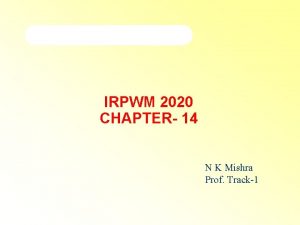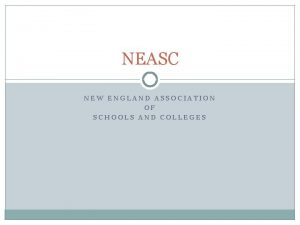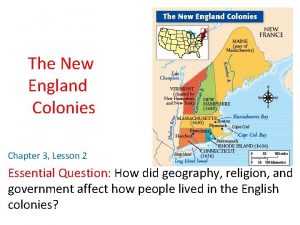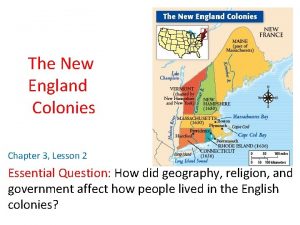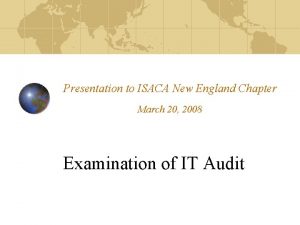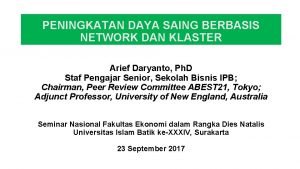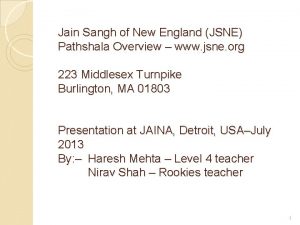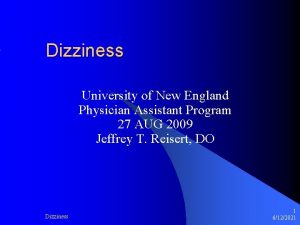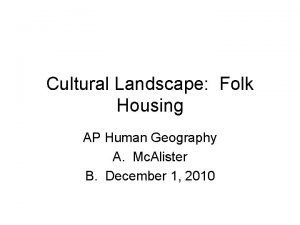Microsoft New England Research and Development Center June
































![“Spambot. py” (continued) wordlemmatizer = Word. Net. Lemmatizer() commonwords = stopwords('english') hamtexts = [] “Spambot. py” (continued) wordlemmatizer = Word. Net. Lemmatizer() commonwords = stopwords('english') hamtexts = []](https://slidetodoc.com/presentation_image_h/027f687b1ace247484644d4dd8a322e3/image-33.jpg)











![easy_install tweetstream import tweetstream words = ["green lantern"] with tweetstream. Track. Stream(“yourusername", “yourpassword", words) easy_install tweetstream import tweetstream words = ["green lantern"] with tweetstream. Track. Stream(“yourusername", “yourpassword", words)](https://slidetodoc.com/presentation_image_h/027f687b1ace247484644d4dd8a322e3/image-45.jpg)



- Slides: 48

Microsoft New England Research and Development Center, June 22, 2011 Natural Language Processing and Machine Learning Using Python Shankar Ambady |

Example Files Hosted on Github https: //github. com/shanbady/NLTK-Boston-Python-Meetup

What is “Natural Language Processing”? i. Where is this stuff used? i. ii. The Machine learning paradox ii. A look at a few key terms iii. Quick start – creating NLP apps in Python

What is Natural Language Processing? • Computer aided text analysis of human language. • The goal is to enable machines to understand human language and extract meaning from text. • It is a field of study which falls under the category of machine learning and more specifically computational linguistics. • The “Natural Language Toolkit” is a python module that provides a variety of functionality that will aide us in processing text.

Natural language processing is heavily used throughout all web technologies Search engines Consumer behavior analysis Advertising (mining context) Automated customer support systems Site recommendations Spam filtering Knowledge bases and expert systems

Paradoxes in Machine Learning Sentiment Ambiguity Intent Context • Sarcasm • Slang • Emphasis • Time and date • Since when did “google” become a verb?

Context Little sister: What’s your name? Me: Uhh…. Shankar. . ? Sister: Can you spell it? Me: yes. S-H-A-N-K-A…. .

Sister: WRONG! It’s spelled “I-T”

Language translation is a complicated matter! Go to: http: //babel. mrfeinberg. com/ The problem with communication is the illusion that it has occurred

The problem with communication is the illusion that it has occurred Das Problem mit Kommunikation ist die Illusion, dass es aufgetreten ist The problem with communication is the illusion that it arose Das Problem mit Kommunikation ist die Illusion, dass es entstand The problem with communication is the illusion that it developed Das Problem mit Kommunikation ist die Illusion, die sie entwickelte The problem with communication is the illusion, which developed it

The problem with communication is the illusion that it has occurred The problem with communication is the illusion, which developed it EPIC FAIL

Police police. The above statement is a complete sentence states that: “police officers police other police officers”. She yelled “police” “someone called for police”.

Key Terms

The NLP Pipeline Segmentation (tokenizing) Normalization Named Entity Recognition

Collocations • Short sequences of words that commonly appear together. • Commonly used to provide search suggestions as users type. N-Grams • Tokens consisting of one or more words: • Unigrams • Bigrams • Trigrams

Setting up NLTK • Source downloads available for mac and linux as well as installable packages for windows. • Currently only available for Python 2. 5 – 2. 6 • http: //www. nltk. org/download • `easy_install nltk` • Prerequisites – Num. Py – Sci. Py

First steps • NLTK comes with packages of corpora that are required for many modules. • Open a python interpreter: import nltk. download() If you do not want to use the downloader with a gui (requires TKInter module) Run: python -m nltk. downloader <name of package or “all”>

You may individually select packages or download them in bulk.

Let’s dive into some code!

Part of Speech Tagging from nltk import pos_tag, word_tokenize sentence 1 = 'this is a demo that will show you how to detects parts of speech with little effort using NLTK!' tokenized_sent = word_tokenize(sentence 1) print pos_tag(tokenized_sent) [('this', 'DT'), ('is', 'VBZ'), ('a', 'DT'), ('demo', 'NN'), ('that', 'WDT'), ('will', 'MD'), ('show', 'VB'), ('you', 'PRP'), ('how', 'WRB'), ('to', 'TO'), ('detects', 'NNS'), ('parts', 'NNS'), ('of', 'IN'), ('speech', 'NN'), ('with', 'IN'), ('little', 'JJ'), ('effort', 'NN'), ('using', 'VBG'), ('NLTK', 'NNP'), ('!', '. ')]

Penn Bank Part-of-Speech Tags CC CD DT EX FW IN JJ JJR JJS LS MD NN NNS NP NPS Coordinating conjunction Cardinal number Determiner Existential "there" Foreign word Prepostion or subordination conjunction Adjective- comparative Adjective- superlative List item marker Modal Noun- singular or mass Noun- plural Proper noun- singular Proper noun- plural Source: http: //www. ai. mit. edu/courses/6. 863/tagdef. html

NLTK Text nltk. clean_html(rawhtml) from nltk. corpus import brown from nltk import Text brown_words = brown. words(categories='humor') brown. Text = Text(brown_words) brown. Text. collocations() brown. Text. count("car") brown. Text. concordance("oil") brown. Text. dispersion_plot(['car', 'document', 'funny', 'oil']) brown. Text. similar('humor')

Find similar terms (word definitions) using Wordnet import nltk from nltk. corpus import wordnet as wn synsets = wn. synsets('phone') print [str(syns. definition) for syns in synsets] 1) 'electronic equipment that converts sound into electrical signals that can be transmitted over distances and then converts received signals back into sounds‘ 2) '(phonetics) an individual sound unit of speech without concern as to whether or not it is a phoneme of some language‘ 3) 'electro-acoustic transducer for converting electric signals into sounds; it is held over or inserted into the ear‘ 4) 'get or try to get into communication (with someone) by telephone'

from nltk. corpus import wordnet as wn synsets = wn. synsets('phone') print [str( syns. definition ) for syns in synsets] “syns. definition” can be modified to output hypernyms , meronyms, holonyms etc:

Fun things to Try

Feeling lonely? Eliza is there to talk to you all day! What human could ever do that for you? ? from nltk. chat import eliza_chat() ……starts the chatbot Therapist ----Talk to the program by typing in plain English, using normal upperand lower-case letters and punctuation. Enter "quit" when done. ==================================== = Hello. How are you feeling today?

Englisch to German to Englisch to German…… from nltk. book import * babelize_shell() Babel> the internet is a series of tubes Babel> german Babel> run 0> the internet is a series of tubes 1> das Internet ist eine Reihe Schl. Suche 2> the Internet is a number of hoses 3> das Internet ist einige Schl. Suche 4> the Internet is some hoses Babel>

Let’s build something even cooler

Lets write a spam filter! A program that analyzes legitimate emails “Ham” as well as “spam” and learns the features that are associated with each. Once trained, we should be able to run this program on incoming mail and have it reliably label each one with the appropriate category.

What you will need 1. NLTK (of course) as well as the “stopwords” corpus 1. A good dataset of emails; Both spam and ham 2. Patience and a cup of coffee (these programs tend to take a while to complete)

Finding Great Data: The Enron Emails • A dataset of 200, 000+ emails made publicly available in 2003 after the Enron scandal. • Contains both spam and actual corporate ham mail. • For this reason it is one of the most popular datasets used for testing and developing anti-spam software. The dataset we will use is located at the following url: http: //labs-repos. iit. demokritos. gr/skel/i-config/downloads/enronspam/preprocessed/ It contains a list of archived files that contain plaintext emails in two folders , Spam and Ham.

1. Extract one of the archives from the site into your working directory. 2. Create a python script, lets call it “spambot. py”. 3. Your working directory should contain the “spambot” script and the folders “spam” and “ham”. “Spambot. py” from nltk import word_tokenize, Word. Net. Lemmatizer, Naive. Bayes. Classifier , classify, Maxent. Classifier from nltk. corpus import stopwords import random import os, glob, re
![Spambot py continued wordlemmatizer Word Net Lemmatizer commonwords stopwordsenglish hamtexts “Spambot. py” (continued) wordlemmatizer = Word. Net. Lemmatizer() commonwords = stopwords('english') hamtexts = []](https://slidetodoc.com/presentation_image_h/027f687b1ace247484644d4dd8a322e3/image-33.jpg)
“Spambot. py” (continued) wordlemmatizer = Word. Net. Lemmatizer() commonwords = stopwords('english') hamtexts = [] load common English words into list spamtexts = [] start globbing the files into the appropriate lists for infile in glob( os. path. join('ham/', '*. txt') ): text_file = open(infile, "r") hamtexts. extend(text_file. read()) text_file. close() for infile in glob( os. path. join('spam/', '*. txt') ): text_file = open(infile, "r") spamtexts. extend(text_file. read()) text_file. close()

“Spambot. py” (continued) label each item with the appropriate label and store them as a list of tuples mixedemails = ([(email, 'spam') for email in spamtexts] mixedemails += [(email, 'ham') for email in hamtexts]) From this list of random but labeled emails, we will defined a “feature extractor” which outputs a feature set that our program can use to statistically compare spam and ham. random. shuffle(mixedemails) lets give them a nice shuffle

“Spambot. py” (continued) def email_features(sent): features = {} wordtokens = [wordlemmatizer. lemmatize(word. lower()) for word in word_tokenize(sent)] Normalize words for word in wordtokens: if word not in commonwords: features[word] = True return features If the word is not a stop-word then lets consider it a “feature” Let’s run each email through the feature extractor and collect it in a “featureset” list featuresets = [(email_features(n), g) for (n, g) in mixedemails]

- The features you select must be binary features such as the existence of words or part of speech tags (True or False). - To use features that are non-binary such as number values, you must convert it to a binary feature. This process is called “binning”. - If the feature is the number 12 the feature is: (“ 11<x<13”, True)

“Spambot. py” (continued) Lets grab a sampling of our featureset. Changing this number will affect the accuracy of the classifier. It will be a different number for every classifier, find the most effective threshold for your dataset through experimentation. size = int(len(featuresets) * 0. 5) Using this threshold grab the first n elements of our featureset and the last n elements to populate our “training” and “test” featuresets train_set, test_set = featuresets[size: ], featuresets[: size] Here we start training the classifier using NLTK’s built in Naïve Bayes classifier = Naive. Bayes. Classifier. train(train_set)

“Spambot. py” (continued) print classifier. labels() This will output the labels that our classifier will use to tag new data ['ham', 'spam'] The purpose of create a “training set” and a “test set” is to test the accuracy of our classifier on a separate sample from the same data source. print classify. accuracy(classifier, test_set) 0. 75623

classifier. show_most_informative_features(20) Ham Spam ect ham 46: 1 2004 spam 43. 5: 1 cc ham 40. 2: 1 removed spam 42. 9: 1 kitchen ham 39. 1: 1 thousand spam 38. 2: 1 wednesday ham 29. 8: 1 prescription spam 34. 2: 1 shirley ham 29. 1: 1 doctor spam 28. 9: 1 meeting ham 26. 8: 1 super spam 26. 9: 1 houston ham 24. 3: 1 quality spam 26. 9: 1 thursday ham 23. 9: 1 drug spam 26. 9: 1 2001 ham 19. 1: 1 remove spam 26. 1: 1 mary ham 19. 1: 1 cheap spam 24. 9: 1

“Spambot. py” (continued) While True: featset = email_features(raw_input("Enter text to classify: ")) print classifier. classify(featset) We can now directly input new email and have it classified as either Spam or Ham

A few notes: -The quality of your input data will affect the accuracy of your classifier. - The threshold value that determines the sample size of the feature set will need to be refined until it reaches its maximum accuracy. This will need to be adjusted if training data is added, changed or removed.

A few notes: - The accuracy of this dataset can be misleading; In fact our spambot has an accuracy of 98% - but this only applies to Enron emails. This is known as “over-fitting”. - Try classifying your own emails using this trained classifier and you will notice a sharp decline in accuracy.

Real-time Reviews We will use the same classification script but modify it to detect positive and negative movie tweets in real-time! You will need the rotten tomatoes polarity dataset: http: //www. cs. cornell. edu/people/pabo/movie-review-data/rotten_imdb. tar. gz

Two Labels rotten Fresh Flixster, Rotten Tomatoes, the Certified Fresh Logo are trademarks or registered trademarks of Flixster, Inc. in the United States and other countries
![easyinstall tweetstream import tweetstream words green lantern with tweetstream Track Streamyourusername yourpassword words easy_install tweetstream import tweetstream words = ["green lantern"] with tweetstream. Track. Stream(“yourusername", “yourpassword", words)](https://slidetodoc.com/presentation_image_h/027f687b1ace247484644d4dd8a322e3/image-45.jpg)
easy_install tweetstream import tweetstream words = ["green lantern"] with tweetstream. Track. Stream(“yourusername", “yourpassword", words) as stream: for tweet in stream: tweettext = tweet. get('text', '') tweetuser = tweet['user']['screen_name']. encode('utf-8') featset = review_features(tweettext) print tweetuser, ': ', tweettext print tweetuser, “ thinks Green Lantern is ", classifier. classify(featset), "nnn--------------"


Further Resources: • I will be uploading this presentation to my site: – http: //www. shankarambady. com • “Natural Language Processing with Python” by Steven Bird, Ewan Klein, and Edward Loper – http: //www. nltk. org/book • API reference : http: //nltk. googlecode. com/svn/trunk/doc/api/index. html • Great NLTK blog: – http: //streamhacker. com/

Thank you for watching! Special thanks to: John Verostek and Microsoft!
 Microsoft new england research and development center
Microsoft new england research and development center China aerodynamics research and development center
China aerodynamics research and development center Learning research and development center
Learning research and development center Ohio agricultural research and development center
Ohio agricultural research and development center Irpwm 2020
Irpwm 2020 North middle and southern colonies
North middle and southern colonies Middle colonies date founded
Middle colonies date founded Comparing colonial regions chart
Comparing colonial regions chart New england, middle and southern colonies comparison chart
New england, middle and southern colonies comparison chart Pegs new england colonies
Pegs new england colonies New england association of schools and colleges
New england association of schools and colleges New england region
New england region Development research centre of the state council
Development research centre of the state council When was the new england colonies founded
When was the new england colonies founded Where is plymouth
Where is plymouth Lesson 2 the new england colonies answer key
Lesson 2 the new england colonies answer key What was the new england confederation
What was the new england confederation What is considered new england
What is considered new england New england rocky soil
New england rocky soil New england power generators association
New england power generators association New england colonies leaders
New england colonies leaders Southern colonies
Southern colonies New england location
New england location New england outline
New england outline Wneu self service
Wneu self service What is included in new england
What is included in new england Facts about 13 colonies
Facts about 13 colonies New england colonies leaders
New england colonies leaders Middle colonies
Middle colonies Slavery in the 13 colonies chart
Slavery in the 13 colonies chart Chapter 2 section 3 puritan new england
Chapter 2 section 3 puritan new england Isaca new england
Isaca new england Klaster
Klaster New england renaissance
New england renaissance New england federation of humane societies
New england federation of humane societies The new england colonie
The new england colonie Jsne
Jsne Ohio militia
Ohio militia What is this
What is this Anglican diocese of new england
Anglican diocese of new england Uscg sector southeastern new england
Uscg sector southeastern new england The new england renaissance
The new england renaissance Middle colonies terrain
Middle colonies terrain Middle colonies physical characteristics
Middle colonies physical characteristics New england journal of medicine
New england journal of medicine Folk ecology
Folk ecology University of new england physician assistant program
University of new england physician assistant program Folk housing examples
Folk housing examples The new england journal of medicine
The new england journal of medicine




